During What Period of Art Was Frida Kahlo Most Famous for?
Frida Kahlo is regarded equally a folk hero due to her distinct character and diverse background. She has become a symbol of female willpower, a passion for Mexico and its history, and tenacity in the presence of adversities. Beyond all else, she was an accurate female who stood firm in her beliefs. Frida Kahlo's original paintings typically had deep personal themes and blended reality and imagination. If you have ever asked yourself "what is Frida Kahlo known for?", then look no further, we volition be taking a cursory expect at her life besides as Frida Kahlo's most famous paintings.
Tabular array of Contents
- ane Who Is Frida Kahlo?
- ii A Look at the Well-nigh Of import Frida Kahlo Paintings
- 2.1 Frieda and Diego Rivera (1931)
- 2.two Henry Ford Hospital (1932)
- 2.3 My Birth (1932)
- two.4 My Grandparents, My parents, and I (1936)
- ii.five Fulang-Chang and I (1937)
- 2.6 The Suicide of Dorothy Hale (1938)
- 2.7 What the Water Gave Me (1938)
- 2.viii The Two Fridas (1939)
- 2.ix Self-Portrait with Cropped Pilus (1940)
- 2.10 Self-portrait with Thorn Necklace and Hummingbird (1940)
- 2.11 The Broken Cavalcade (1944)
- ii.12 Without Hope (1945)
- 2.thirteen The Wounded Deer (1946)
- 2.14 Weeping Coconuts (1951)
- iii Frequently Asked Questions
- 3.ane What Is Frida Kahlo Known For?
- 3.2 What Was Frida Kahlo'southward Art Style?
Who Is Frida Kahlo?
Frida Kahlo was a Mexican artist who explored various topics like race, gender, and sexuality in her paintings. She is renowned for her provocative and ofttimes autobiographical artworks, and today, Kahlo stands as a respected feminist icon and famed artist.
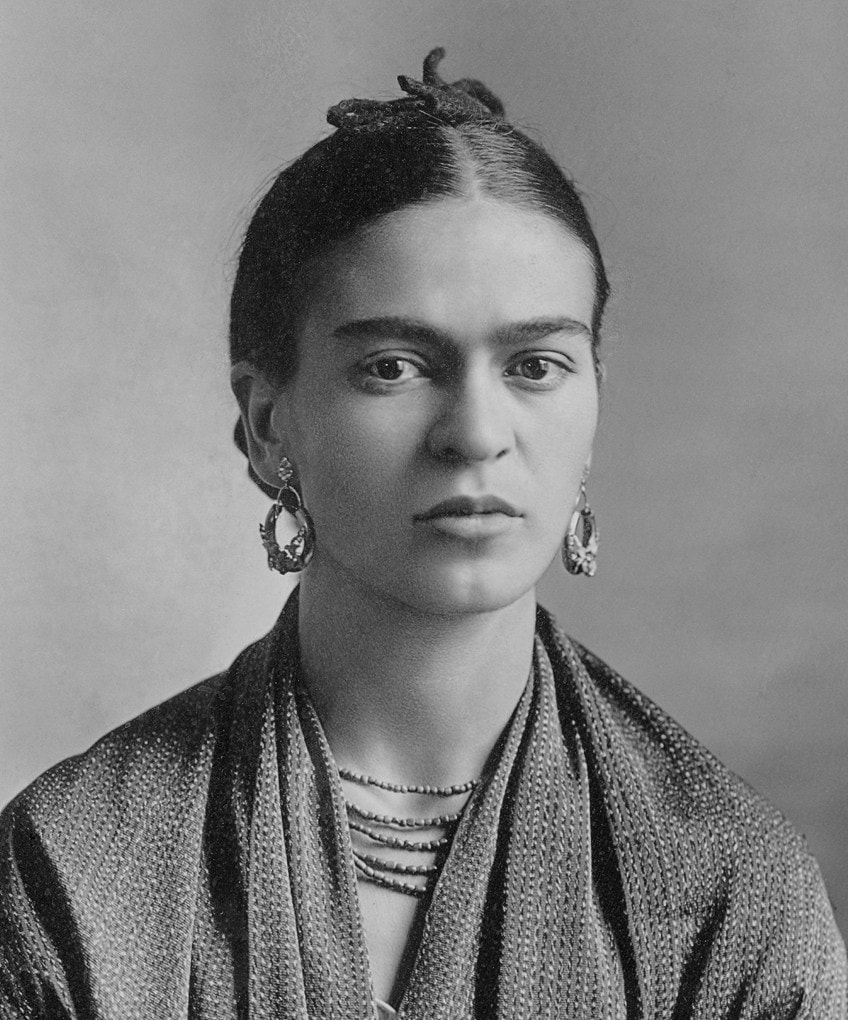 A print of Frida Kahlo, 1932;Guillermo Kahlo, Public domain, via Wikimedia Commons
A print of Frida Kahlo, 1932;Guillermo Kahlo, Public domain, via Wikimedia Commons
She was built-in in 1907 at the Blue Business firm in Coyoacan, a hamlet on the fringes of Mexico City. Her father, Wilhelm, was from Germany and had migrated to Mexico in his youth, where he resided for the balance of his lifetime, ultimately taking over his family's photographic company. Matilde, Frida Kahlo's mother, was of blended Mexican native and Spanish heritage and reared Frida and her younger siblings in a disciplined and devout home.
Kahlo always asserted to take been born in 1910, the very aforementioned twelvemonth every bit the revolution in Mexico, so that others might link her with contemporary United mexican states.
This insight unveils to us a unique persona, marked since early life by a profound feeling of autonomy and defiance against customary moral and social practices, moved by devotion and passion, supportive of her "Mexicanidad" and traditional beliefs fix confronting the ruling Americanization while maintaining a distinctive sense of humour.
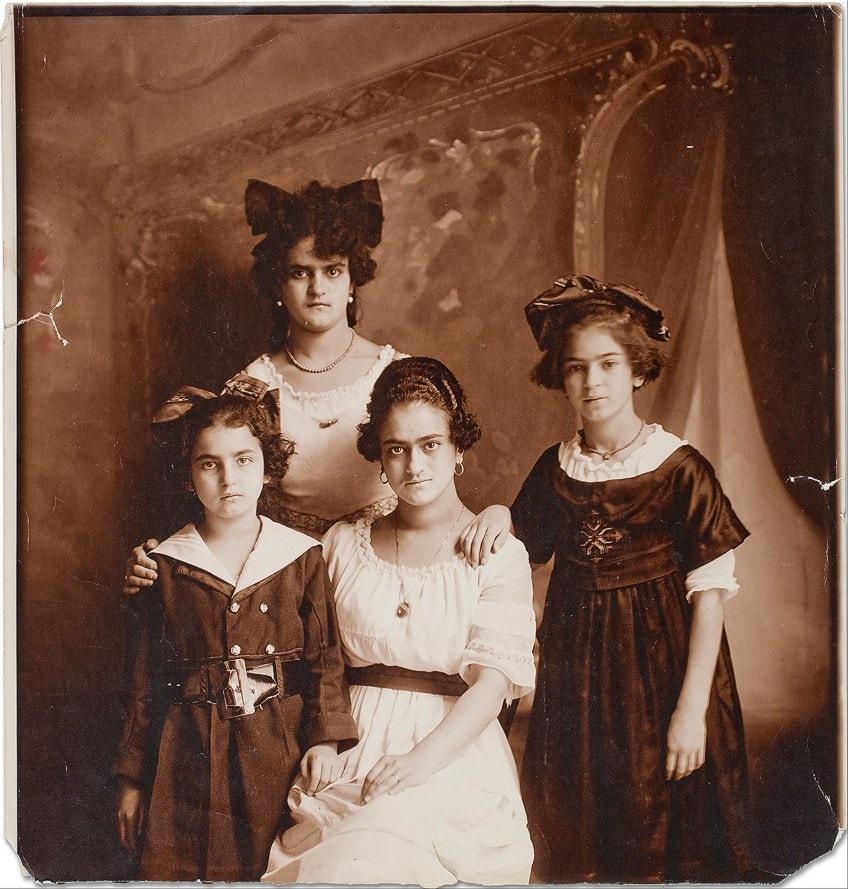 Matilde, Adriana, Frida and Cristina Kahlo (1916);Guillermo Kahlo, Public domain, via Wikimedia Commons
Matilde, Adriana, Frida and Cristina Kahlo (1916);Guillermo Kahlo, Public domain, via Wikimedia Commons
Her life was defined by severe hurting, beginning with polio at five years of age and later followed by a passenger vehicle accident that resulted in all-encompassing damage to her body. Many of her masterpieces were created when she was resting in bed. Kahlo'south paintings are typically marked by depictions of desperation, owing to her personal traumas, losses, and multiple procedures. 55 of the 143 artworks are Frida Kahlo self-portraits, which oft include allegorical depictions of physical and mental scars.
Every bit a youthful painter, Kahlo contacted the legendary Mexican artist Diego Rivera, who best-selling that Frida Kahlo's art mode was really original and distinctively Mexican.
They wed in 1929, against Kahlo'south family'south displeasure, separated, and then married over again in 1940. She had several partners, both males and females, including Leon Trotsky and the wife of André Breton. She remarked in her periodical simply several days prior to her passing on July xiii, 1954, "I trust the departure is pleasant – and I wish not to e'er come up back – Frida." The official coroner'southward report stated that pulmonary embolism was the crusade of death, although several speculated that she died of an accidental overdose.
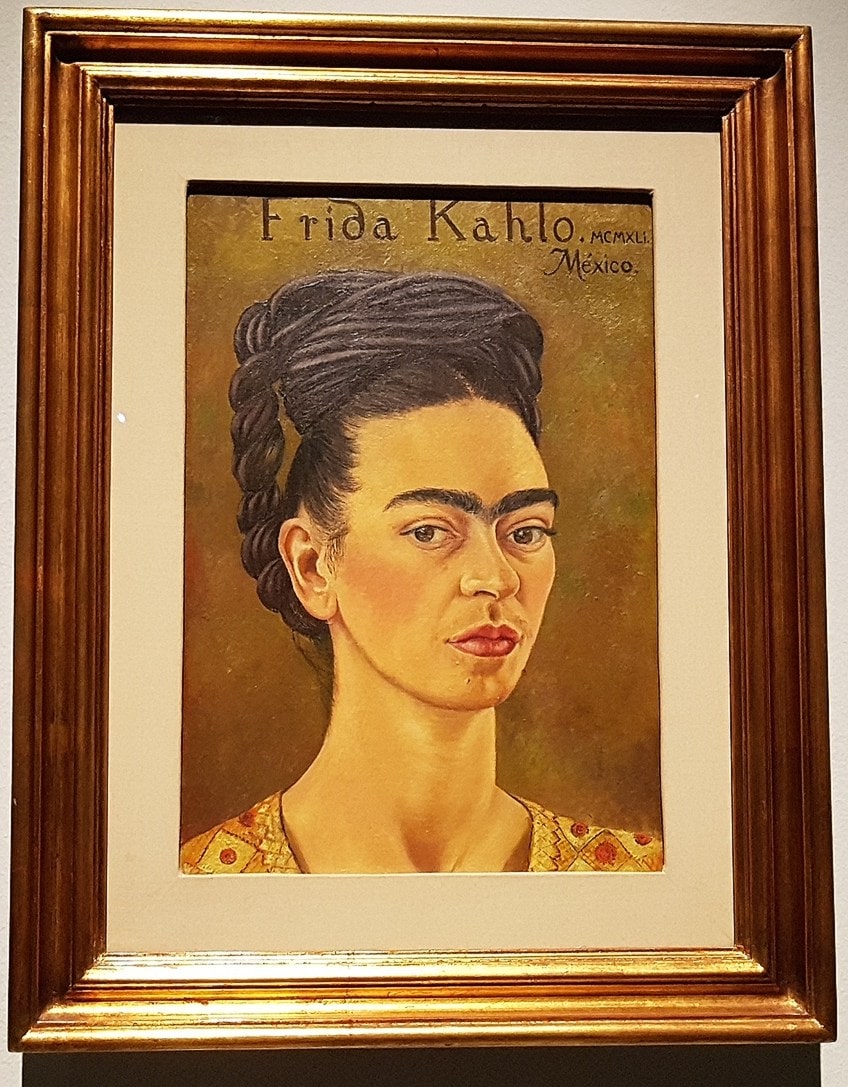 Self-portrait (1941) by Frida Kahlo;Ambra75, CC By-SA iv.0, via Wikimedia Commons
Self-portrait (1941) by Frida Kahlo;Ambra75, CC By-SA iv.0, via Wikimedia Commons
A Look at the Near Important Frida Kahlo Paintings
At present that we have a ameliorate agreement of the person, information technology is now time to swoop into Frida Kahlo'southward famous paintings. They will give us insight into the importance of Frida Kahlo'due south art style and motivations. These paintings past Frida Kahlo volition also present even deeper insight into her psyche and thoughts than her biography.
Frieda and Diego Rivera (1931)
| Date Completed | 1931 |
| Medium | Oil on Canvas |
| Dimensions | 100 cm ten 78 cm |
| Currently Housed | San Francisco Museum of Mod Art |
Information technology's as though Kahlo is trying on the homemaker role in this piece to see how information technology suits her. She is unconcerned with her status as an artist, preferring to play a submissive and supporting position, grasping the hand of her creative and famous spouse. It is true that for the bulk of her artistic activeness, Kahlo was shrouded in the shadow of Rivera, and it would merely be later in her lifetime that she achieved widespread acclaim. This early double-portrait was created largely to commemorate Kahlo's hymeneals to Rivera.
While Rivera is holding a palette and brush, symbols of his artistic prowess, Kahlo restricts her position to that of her spouse past portraying herself in a small frame and without her artistic accessories.
Kahlo likewise appears in the customary Mexican female'south attire, donning a typical crimson cloak called the rebozo and jade jewelry. The posture of the characters is like to that of customary marital portraits, in which the woman is positioned to the left of her spouse to symbolize her lower social position equally a female. The painter does grasp her personal palette in a sketch done the next twelvemonth chosen Frida and the Miscarriage every bit if the trauma of losing a child and not being able to make a family unit redirects her focus entirely to the production of art.
Henry Ford Hospital (1932)
| Date Completed | 1932 |
| Medium | Oil on Canvass |
| Dimensions | 30 cm 10 38 cm |
| Currently Housed | Dolores Olmedo Collection, Mexico |
A big number of Frida Kahlo'due south paintings from the 1930s specially in calibration, format, structural location, and spatial configuration, are related to theological ex-voto artworks, of which she and Rivera endemic a meaning library spanning many hundreds of years. Ex-votos are deposited in temples or monuments as a testify of thank you for redemption, an answered plea, or avoided cataclysm.
Ex-votos are often created on tiny metallic surfaces, depicting the occurrence too every bit the Virgin or saints to whom they are presented.
Kahlo employs the ex-voto method only undercuts it by putting herself in the center position instead of documenting the wondrous deportment of martyrs in Henry Ford Hospital. Rather, she depicts her own tale, equally if she's a martyr, and the artwork is created not in gratitude to the Omnipotent, but in rebellion, wondering why he causes her agony.
In this artwork, Kahlo is hemorrhaging on a mattress after a miscarriage. Half dozen vein-like streamers run forth from the bare nude trunk, each linked to a symbol. One of the six items is a fetus, implying that the streamers are an illustration for umbilical cords. The residual of the objects that encircle Kahlo are objects she recalls or has seen while in the clinic. The snail, for instance, refers to the time it took for the miscarriage to end, just the blossom was a existent thing presented to her by Diego.
The painter displays her urge to exist connected to everything around her, including the everyday and symbolic every bit well as the tangible and real. Perhaps information technology is through this trying to connect that Kahlo attempts to be motherly despite her inability to have her own baby.
My Nativity (1932)
| Engagement Completed | 1932 |
| Medium | Oil on Zinc |
| Dimensions | 30 cm x 35 cm |
| Currently Housed | Individual Collection |
This is a disturbing artwork where both the giver of nascency and the infant born appear to be deceased. The female parent giving birth has her head wrapped in white linen, and the infant coming from the belly seems dead. Considering Kahlo's mother had merely passed at the moment she created this piece, it appears plausible to infer that the veiled funeral figure is her mother and the infant is Kahlo. She had recently lost her ain kid and has stated that she is the unnoticed mother figure. The Virgin of Sorrows, which hangs over the bed, implies that this is a depiction of parental agony and grief.
Adjacent to numerous little sketches of herself, Kahlo wrote in her periodical, "the ane who birthed herself is also who equanimous the nearly exquisite poetry of her life."
Like to several other of Frida Kahlo'southward original paintings, this artwork depicts Kahlo grieving the decease of a kid while having the fortitude to create not bad piece of work as a result of such grief. The artwork is done in a devotional fashion, a tiny indigenous Mexican film inspired from Catholic Church iconography) with gratitude to the Virgin underneath the picture.
Rather, Kahlo left this part vacant, as if she is unwilling to express gratitude for either her own conception or the condition that she is at present unable to bear children.
The motion-picture show appears to convey the notion that information technology is critical to recognize that formulation and mortality are inextricably linked. Many people believe that My Nativity was profoundly influenced past an Aztec sculpture Kahlo kept at home depicting Tlazolteotl, the Deity of Fertility and Midwifery.
My Grandparents, My parents, and I (1936)
| Date Completed | 1936 |
| Medium | Tempera and Oil on Zinc |
| Dimensions | 31 cm 10 34 cm |
| Currently Housed | Museum of Modern Fine art, New York |
This dreamy family tree was produced on zinc instead of canvas, emphasizing the creator'southward interest with her appreciation of 18th-century Mexican retablos. Kahlo produced this slice to highlight both her European Jewish ancestry and her Mexican ethnicity. Her begetter's side, German Jewish, is portrayed on the correct-hand side of the painting past the ocean (reflecting her father's trip to United mexican states), while her mother'due south one-half, Mexican, is presented on the left by a nautical chart softly delineating Mexico'due south geography.
While Frida Kahlo'due south famous paintings are unmistakably personal, she frequently utilized them to convey subversive or geopolitical ideas.
This picture was made just after Hitler enacted the Nuremberg laws prohibiting mixed marriages. Here, Kahlo concurrently acknowledges her mixed background while confronting Nazi ideology, employing a structure used by the Nazi regime to assess ethnic superiority – the genealogy tree. Aside from geopolitics, the cherry thread used to bind the relatives recalls the umbilical cord that ties infant Kahlo to her mom, a theme that appears within many paintings by Frida Kahlo.
Fulang-Chang and I (1937)
| Date Completed | 1937 |
| Medium | Oil on Board |
| Dimensions | 40 cm 10 28 cm |
| Currently Housed | Museum of Modern Art, New York |
This artwork was amidst the pieces that most intrigued André Breton, the creator of the Surrealist movement when it premiered during Kahlo's show in 1938 in Julien Levy's gallery in New York. The painting in the New York exhibition is a cocky-portrait of the painter and her pet monkey, Fulang-Chang, who serves every bit a proxy for the babies that she and Rivera were unable to excogitate. The portrait's character layout reflects her fascination with Renaissance artworks of the Madonna and Child. Post-obit the New York show, a secondary frame with a mirror was installed.
The subsequent insertion of the mirror is a statement welcoming the spectator inside the artwork: it was during her months detained at home following her blow that she first started producing portraiture, excavation further into her mind by staring at herself closely at her reflection.
When viewed from this angle, the add-on of the mirror provides a surprisingly personal glimpse into both the painter's artistic processes and her inner reflection. Several of Frida Kahlo's cocky-portraits feature primates, dogs, and birds, all of which she owned as companions.
Piddling spider monkeys, like those owned past Kahlo, take been idea to represent Satan, blasphemy, and idolatry since the Medieval Era, eventually coming to symbolize the downfall of humanity, depravity, and the paradigm of desire. In the past, these primates were represented equally a warning about the perils of obsessive affection and humanity'due south bones inclinations.
In artworks from both 1939 and 1940, Kahlo is seen with her monkey. In a second rendition, completed in 1945, Kahlo depicts her monkey every bit well equally her dog. This small canine, who often accompanies the painter, is named afterward a legendary Aztec god believed to symbolize thunder and destruction, as well as the twin of Quetzalcoatl, both of whom had explored the underworld. All of these images, notably Fulang-Chang and I, have 'umbilical' cords wrapped around Kahlo'southward and the creatures' throats.
Kahlo is the Madonna, and her dogs take on the role of the sacred (simply deeply allegorical) kid she yearns for.
The Suicide of Dorothy Hale (1938)
| Date Completed | 1938 |
| Medium | Oil on Canvas |
| Dimensions | 49 cm x threescore cm |
| Currently Housed | Phoenix Art Museum |
Dorothy Hale was a showgirl from the United states of america. She had a few failed romances and her business was faltering when her spouse was killed in a car crash. She killed herself on the 21st of October, 1938, because she was in serious monetary difficulty and had to rely on the generosity of her affluent acquaintances. She leaped out the top balcony of her luxurious condominium suite in New York, wearing her favorite blackness gown and a bouquet of tiny xanthous flowers.
Clare Boothe Luce, Dorothy'south shut, personal friend and lover of Frida Kahlo, as well as the founder of the magazine "Vanity Off-white," contracted Kahlo to paint a retention moving-picture show of their departed common friend for $400 most instantly.
Clare wanted to present this painting as a tribute to Dorothy's bereaved mother. She assumed Frida Kahlo would create a standard picture of Dorothy to place over the curtain.
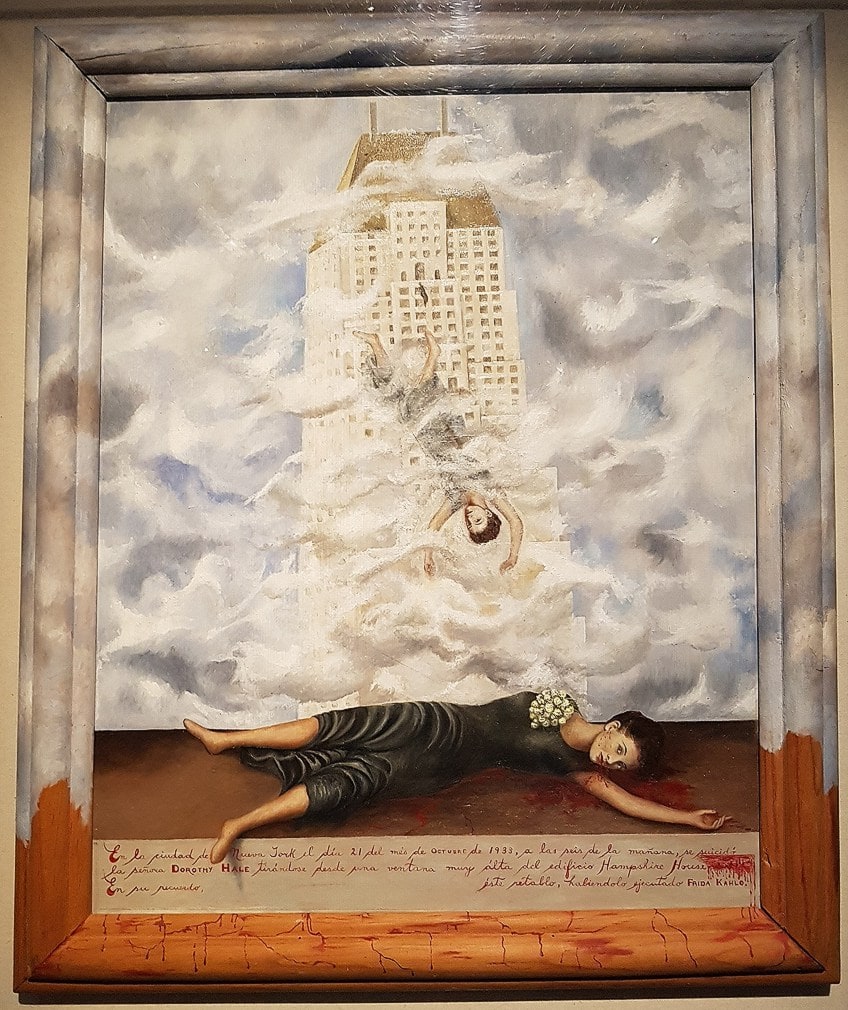 The Suicide of Dorothy Hale (1938) past Frida Kahlo;Ambra75, CC BY-SA 4.0, via Wikimedia Commons
The Suicide of Dorothy Hale (1938) past Frida Kahlo;Ambra75, CC BY-SA 4.0, via Wikimedia Commons
Clare was horrified when the flick came in August 1939 and was opened. She considered burning it, only her companions persuaded her non to. This picture is one of the most frightening paintings past Frida Kahlo and i of her most contentious works, depicting every phase of Hale'south death.
Information technology depicts Hale poised on the ledge, plummeting to her demise, and and so laying on the bloodied sidewalk beneath. Clare donated the picture to Frank Crowninshield, whose kid handed it back to Clare's family when Frank died. Later that, the painting was stored for years. Information technology was privately presented to the Phoenix Art Museum and is now on showroom there.
Kahlo was in profound sadness and contemplating suicide at the time she produced this work, having recently separated from Diego. Kahlo's sympathy for women brought to agony past male abandonment may be shown in this artwork.
What the Water Gave Me (1938)
| Appointment Completed | 1938 |
| Medium | Oil on Canvas |
| Dimensions | 91 cm x 70 cm |
| Currently Housed | Individual Drove |
The bulk of Kahlo'south figure is curtained in this artwork. Nosotros are presented with the plug side of the tub, as well as the creator's toes, which is uncommon. Additionally, Kahlo has a bird's-center viewpoint and gazes from to a higher place on the h2o. Inside the water, Kahlo creates another cocky-portrait, wherein the more typical face prototype is substituted with a slew of symbolism and recurrent themes. Pictures of her family, native Tehuana habiliment, a pierced conch, a lifeless bird, 2 female partners, a corpse, a collapsing tower, a vessel setting sail, and a lady sinking tin be noted in this artwork.
This slice was published in Breton's publication about Surrealism and painting, and Hayden Herrera writes in her volume about Kahlo that the painter herself idea this piece was exceptional.
The characters and things floating in the ocean of Frida Kahlo's painting grade an at once wonderful and real-world of recollection, reminiscent of the tapestries style artwork of Renaissance creative person Pieter Bruegel the Elder. Kahlo stated that it was a sorrowful painting that lamented the absence of her youth. Peradventure the high-strung person in the center represents Kahlo's inner emotional sufferings. The painter was cognizant of the psychological ramifications of her works.
In a chat with Herrera, Kahlo expressed "the viewpoint of oneself that is portrayed in this picture" in "a prolonged metaphysical dialogue." Her concept was nearly the moving-picture show of oneself that you accept since you don't come across your heed.
The encephalon is something that looks just tin can exist observed. It is what one takes along with them to view life. In this painting, the creator's caput is and then properly substituted past the internal ideas that dominate her encephalon. A labia-similar flower and a clump of body hair are depicted between Kahlo's thighs, in addition to a delineation of decease by strangling in the heart of the water.
The fine art is extremely sensual, just it besides demonstrates an obsession with expiry and misery. The tub field of study in art has been prominent since Jacques-Louis David'due south The Death of Marat and has been used by a variety of artists, including Tracey Emin and Francesca Woodman.
The Two Fridas (1939)
| Date Completed | 1939 |
| Medium | Oil on Sheet |
| Dimensions | 174 cm x 173 cm |
| Currently Housed | Museum of Modern Fine art |
This double self-portrait is one of Frida Kahlo'southward most famous paintings, and information technology represents the painter's inner ache afterward her separation from Rivera. The painter is seen on the side in contemporary European clothing, donning the outfit she wore at her wedding to Rivera. Given Rivera'due south intense patriotism during their union, Kahlo grew progressively intrigued in her indigenous heritage and decided to study indigenous Mexican clothing, which she displays in the image on the right. Information technology is the Mexican version of Kahlo that is belongings a pendant with a picture of Rivera.
The turbulent skies in the altitude, equally well as the illustrator'southward wounded heart – a core icon of Christianity as well as an Aztec ceremonial offering – emphasize Kahlo'southward inner anguish and bodily suffering.
Meaningful motifs in Kahlo'southward paintings typically take several levels of significance; the recurring theme of haemorrhage signifies both spiritual and bodily anguish, as well equally the painter's conflicted arroyo toward conventional ideas of gender and reproduction.
Despite the fact that both figures' hearts are visible, the female in the white European costume appears to accept had her heart separated, and the vein that flows from her heart is severed and gushing. The vein that flows from her Tehuana-costumed chest is still intact since it is linked to a tiny moving picture of Diego equally a youngster. While Kahlo'due south heart stays unchanged in the Mexican garment, the Continental Kahlo, estranged from her lover Diego, spills freely upon her garment.
This is not just one of Kahlo's nigh famous paintings, merely it is also her biggest piece.
Self-Portrait with Cropped Pilus (1940)
| Date Completed | 1940 |
| Medium | Oil on Canvas |
| Dimensions | 40 cm x 28 cm |
| Currently Housed | Museum of Modern Art, New York |
The artist is shown as an ambiguous form in this self-portrait. Historians interpret this activity as a combative reaction to Rivera'due south separation request, reflecting her wounded sense of feminine accolade and identity for her relationship'southward failings. Her manly habiliment likewise recalls early family unit photos in which Kahlo decided to wearable a blazer. Kahlo's individuality is also shown through her cut pilus.
She has one severed plait in her left hand and several locks of hair on the ground. Severing a plait represents a renunciation of babyhood and purity, but information technology may also be interpreted equally the severing of a connecting chord (perhaps umbilical) that unites ii individuals or 2 lifestyles. In any case, braids were an important part of Kahlo's persona as the customary La Mexicana, and by chopping them off, she dismissed a office of her old self.
The tresses scattered over the ground recall a former self-portrait created by the Mexican legendary grapheme La Llorona, who is today stripped of her feminine traits.
As the abased threads of tresses abound active at her toes, Kahlo holds a pair of pair of scissors; the locks seem to have a mind of their own equally they screw across the carpet and across the feet of her seat. Higher up her somber flick, Kahlo wrote the words and melody of a ballad that says brutally, "Look, if I adored yous information technology was for your tresses, but that you lot are bald, I don't desire you any longer," affirming Kahlo's own condemnation and renunciation of her feminine duties.
In 1997, lensman Elina Brotherus captured wedding ceremony pictures, well-nigh likely in tribute to Kahlo'due south artwork. Brotherus cutting her hair curt for her hymeneals, the remnants of which her futurity husband clutches in his palms.
The gesture of chopping one's locks as a sign of a turning point occurs in the works of other female person painters also, including Rebecca Horn and Francesca Woodman.
Self-portrait with Thorn Necklace and Hummingbird (1940)
| Date Completed | 1940 |
| Medium | Oil on Canvas |
| Dimensions | 47 cm ten 61 cm |
| Currently Housed | Museum of Modern Art, New York |
Kahlo's forward opinion and external gaze in this self-portrait engage and face up the observer. The painter displays Christ's unraveling garland every bit a pendant that grinds into her throat, representing her identity as a Christian saint and the lasting anguish she felt after her broken wedding. A deceased bird swings in the eye of her pendant, a sign in Mexican sociology custom of fortune charms for romantic beloved.
A black true cat, representing ill fortune and tragedy, kneels below her shoulder, and a monkey, a present from Rivera, is placed to her side.
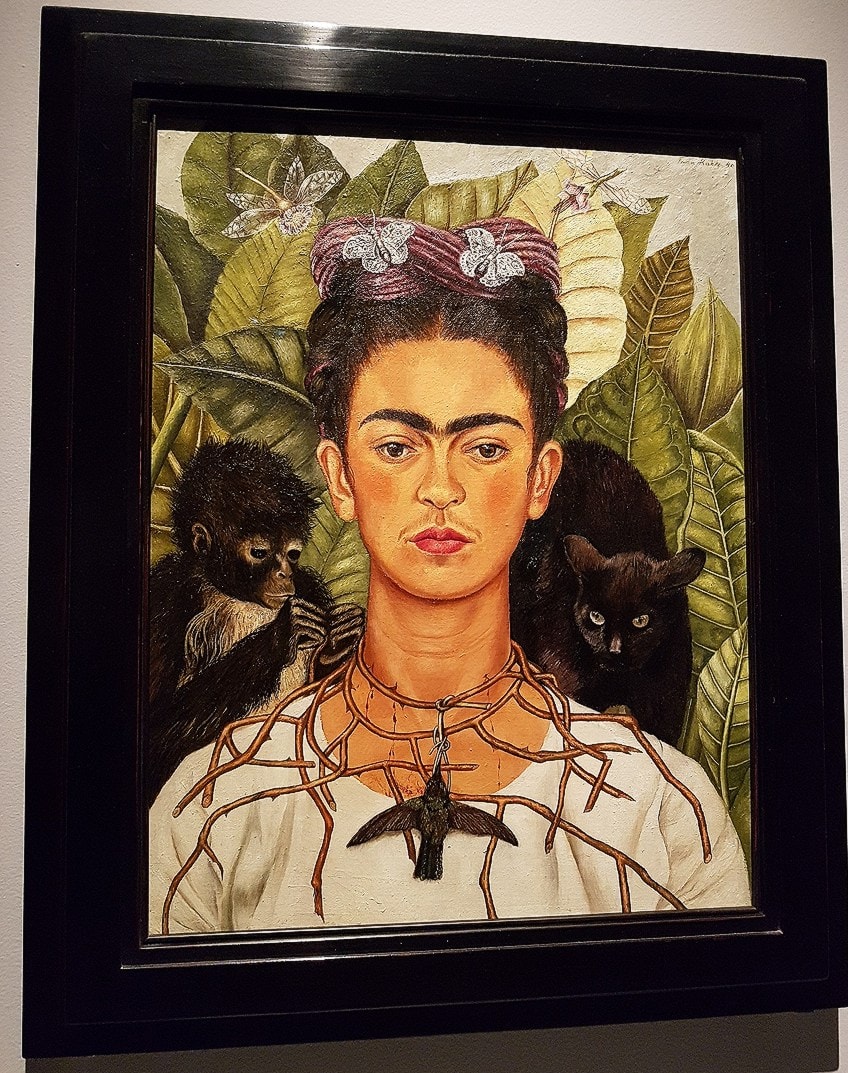 Cocky-portrait with Thorn Necklace and Hummingbird (1940) past Frida Kahlo; Ambra75, CC Past-SA 4.0, via Wikimedia Commons
Cocky-portrait with Thorn Necklace and Hummingbird (1940) past Frida Kahlo; Ambra75, CC Past-SA 4.0, via Wikimedia Commons
Kahlo regularly used plants and wildlife in the properties of her bust-length portrait to generate a pocket-size, cramped environment, utilizing wildlife as a motif to evaluate and compare the relationship betwixt feminine fecundity and the desolate and macabre iconography of the forefront. The symbolism of a 'deceased' hummingbird, which is frequently a point of corking prosperity, is to be inverted. Kahlo, who longs for liberty, is bothered and worried by the reality that the insects in her tresses are also fragile to go far and that the dead animal most her throat has become an impediment, encroached upon by the neighboring cat.
It appears that the artwork depicts the artist's disappointments by being unable to direct communicate complicated inner sentiments.
The Broken Column (1944)
| Date Completed | 1944 |
| Medium | Oil on Masonite |
| Dimensions | 39 cm x thirty cm |
| Currently Housed | Dolores Olmedo Collection, Mexico |
This painting is an particularly poignant delineation of Kahlo's mental and bodily ache. Hayden Herrera, the artist'due south biographer, states of this work, "A scissure like a quake crack breaks her in ii." The exposed trunk alludes to surgeries and Frida's fearfulness that she might autumn to pieces if she didn't wear her steel girdle.
The artist's disintegrating spine has been replaced by a shattered ionic column, and jagged metal nails puncture her body. This implanted cavalcade's harsh coldness echoes the metal rod that entered her belly and uterus during her accident. More than broadly, the now-demolished architectural element conjures upward images of the feminine torso'southward strength and frailty. Aside from its physical proportions, the fabric draped over Kahlo's hips is reminiscent of Christ's loincloth.
Furthermore, Kahlo shows her scars equally if she were a Christian saint; by identifying with Saint Sebastian, she combines actual agony, openness, and eroticism to convey the idea of psychological anguish.
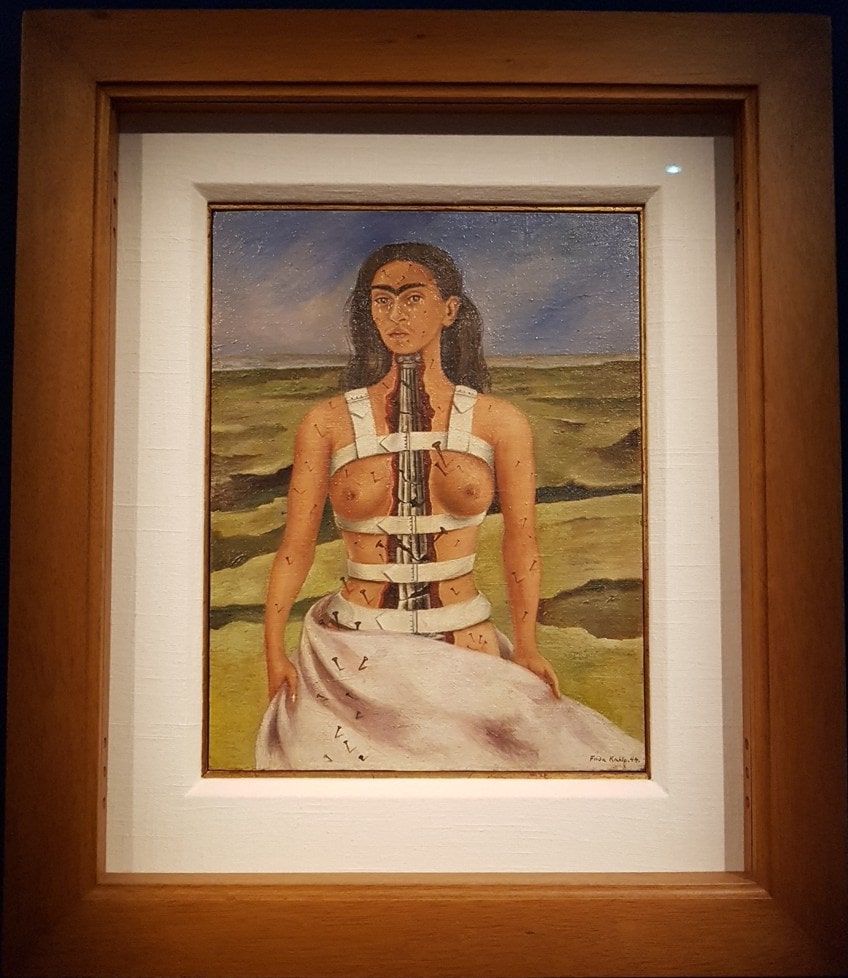 The Broken Column (1944) by Frida Kahlo; Ambra75, CC By-SA 4.0, via Wikimedia Eatables
The Broken Column (1944) by Frida Kahlo; Ambra75, CC By-SA 4.0, via Wikimedia Eatables
Tears stream down the creative person's cheeks, equally they do in many Mexican portrayals of the Madonna; her eyes look out beyond the picture equally if surrendering the trunk and calling the soul. As a consequence of portrayals like this one, Kahlo is now regarded every bit a Magical Realist. Her eyes remain abiding and genuine, while the residue of the image is fanciful.
The artwork is not particularly preoccupied with the functioning of the unconscious or casuistic dissonances, which are more common in Surrealist artworks. The Magic Realism school was increasingly stylish in Latin America (particularly among authors such as Gabriel Garcia Marquez), and scholars take included Kahlo in information technology posthumously.
The concept of existence injured in the manner shown in this painting is known in Castilian every bit "chingada".
This term has a variety of interconnected connotations and notions, such as beingness injured, damaged, ripped open, or misled. The term is derived from the verb for penetrating and denotes masculine dominance over the feminine. It relates to the victim's position. Rebecca Horn's 1970 concert and sculpture piece Unicorn was about likely prompted by the artwork.
Horn wanders nude in an agricultural plain in the piece of work, her torso wrapped in a cloth bodice that looks very comparable to that donned by Kahlo in The Broken Column. The upright, heaven-reaching cavalcade in the work by the functioning creative person, on the other hand, is attached to her skull rather than implanted into her bosom.
The presentation has a mythological and religious feel to it, akin to Kahlo's picture, even so the pillar is complete and powerful again, perhaps paying respect to Kahlo's tenacity and creative accomplishment.
Without Hope (1945)
| Date Completed | 1945 |
| Medium | Oil on Canvas |
| Dimensions | 28 cm x 36 cm |
| Currently Housed | Drove of Dolores Olmedo, Mexico |
Kahlo was immobile for most of her life due to chronic agony and many procedures as a upshot of serious injuries caused in a terrible coach accident in 1925, as well as numerous diseases. The painting was completed in 1945, following her nearly contempo episode of sickness, which left her gaunt and emaciated. Kahlo was administered a 'force-feeding' regimen of fatty pureed foods, which was given to her every two hours.
The movie portrays a sickly Kahlo, with tears in her eyes, laying in bed amid the expressionless arid desert, lit up by both the sun and the moon. In Aztec tradition, the sun represents human sacrifices, and Kahlo feels as though she has been slaughtered. The moon signifies women, maybe the femininity stripped away by her miscarriage, another effect of the tragic tragedy while she was in her youth. She is lying under white medical blankets embossed with tiny organisms, which represent the persistent diseases that have infected her system.
In many paintings by Frida Kahlo, her look is at-home, as if she is reconciled to the suffering and bearing it. Yet, in this painting, all optimism and patience appear to be lost.
Her arms are bound beneath the blankets, and she has footling control over her situation. A gigantic funnel pouring into her lips rises above her torso, a horrific concoction of fish guts, leaking corpses, and other grotesque stuff heaped and spilling from to a higher place. The huge wooden panel congenital past her father to allow Kahlo to create while immobile has evolved into the framework that holds the funnels that nourish her. A typical Mexican saccharide head with Frida'due south moniker across the brow sits atop the rotten nutrient mound, in accord with the Mexican custom of the Day of the Expressionless, which honors those who have died. This is but another striking case of Kahlo'due south dismal condition.
"Non the slightest hope exists for me…everything flows in rhythm with what the stomach carries," is written on the reverse of the artwork.
The Wounded Deer (1946)
| Date Completed | 1946 |
| Medium | Oil on Masonite |
| Dimensions | 30 cm x 22 cm |
| Currently Housed | Individual Collection |
The Wounded Deer, a 1946 artwork, expands on both the concept of chingada and the St. Sebastian subject, which was previously examined in The Cleaved Column. In a woodland meadow, the naïve Kahlo, hybridization of a stag and a female, is injured and hemorrhaging, encroached upon, and pursued. The painter ensures her survival by glancing squarely at the spectator, despite the fact that the shafts would gradually kill her.
The painter wore a pearl earring equally if to emphasize the disharmonize she experiences between her community life and her yearning to dwell more than freely beside the wilderness.
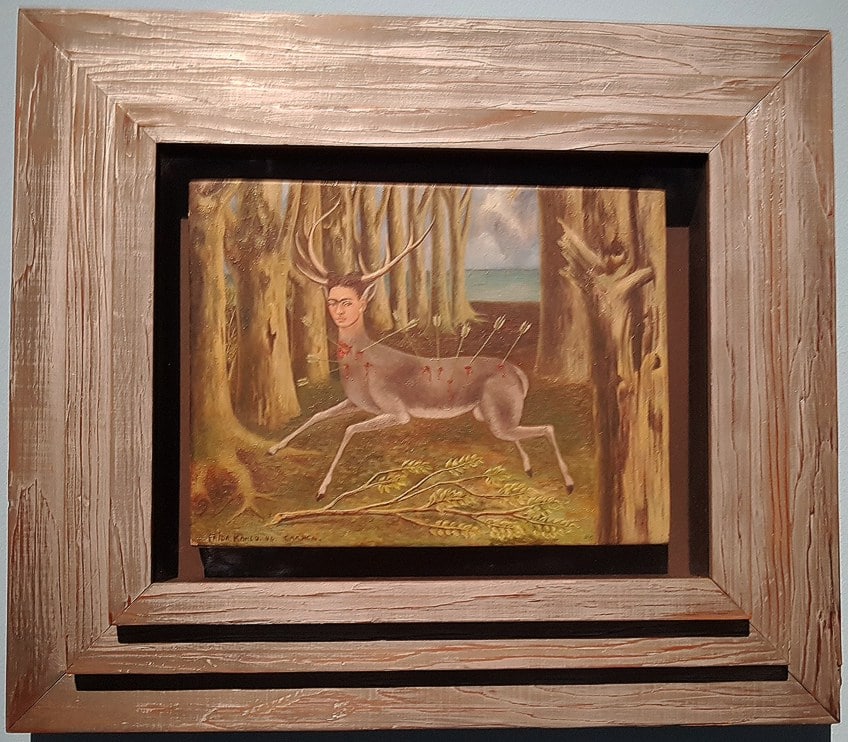 The Wounded Deer (1946) past Frida Kahlo;Ambra75, CC Past-SA 4.0, via Wikimedia Commons
The Wounded Deer (1946) past Frida Kahlo;Ambra75, CC Past-SA 4.0, via Wikimedia Commons
Kahlo portrays herself every bit a concentrated cadet with enormous racks and ballocks, rather than a squeamish and sweet fawn. It would not only imply, as does her matched expect in early family pictures, that Kahlo is intrigued in mixing the genders to class an androgenous character, but it also demonstrates that she tried to identify herself with the other great painters of history, the majority of whom were males.
The limb under the stag's legs is symbolic of the palms fronds put beneath Jesus' anxiety when he landed in Jerusalem. From this moment until her death, Kahlo identified with the Catholic character of Saint Sebastian. She finished a painting of herself with eleven darts piercing her flesh in 1953. Likewise, the artist Louise Bourgeois, who was similarly concerned in the representation of agony, utilized St Sebastian equally a recurring effigy in her work.
She originally represented the subject in 1947 equally an idealized sequence of shapes, hardly identifiable equally a portrait; created using watercolors and pencils on pink paper, but later fashioned an credible pink fabric sculpture of the figure, wounded with darts, suffering nether attack and terrified, like to Kahlo.
Weeping Coconuts (1951)
| Appointment Completed | 1951 |
| Medium | Oil on Lath |
| Dimensions | 23 cm x thirty cm |
| Currently Housed | Los Angeles County Museum of Fine art |
Frida Kahlo's health worsened at the close of her life to the extent where she no longer desired to draw herself through self-portraits and was too practically constrained to working on a smaller scale. She shifted her focus to yet paintings since it was more suitable for the smaller size and demanded less accurateness. Despite the shift in subject from her well-known figurative works, her however lifes managed to communicate a broad variety of emotions.
Weeping Coconuts is a nevertheless life composed of citrus fruits, a piece of papaya, and 2 coconuts set against a obviously dark-green properties. There'southward too a tiny flag put in lime that says "Painted with much devotion." Frida Kahlo produced this every bit a present for Elena Border, just she gave it back to the creative person since she didn't similar the lifeless, gloomy colors and wished to swap it for another slice. Yet, Kahlo covered Elena'south name and resold the picture show without providing her a replacement. The two coconuts that appear to be sobbing are the composition's focal point, as the title indicates.
The coconuts become representations of melancholy, with the marks on their peel resembling weeping eyes.
Frida Kahlo's beauty and skill to paint began to degrade as her wellness deteriorated, and she no longer desired to describe herself, so she selected these coconuts as an alternate medium for conveying her desperation at her destiny. The colors are flatter and heavier than in Frida's previous paintings, and the arrangement emphasizes solitude and sorrow.
The brushwork, which lacks the accuracy and subtlety distinctive of Kahlo'southward paintings, provides more indications of her failing health. This juxtaposition is peculiarly striking when compared to other paintings from the same year. Ultimately, this painting captures Kahlo's tremendous anger and grief at existence bars in her illness-ridden frame, which she eventually rejected as creative inspiration in favor of commonplace items like the fruit and coconuts she depicts in Weeping Coconuts.
And that brings us to the end of our list of important Frida Kahlo paintings. We have learned how many of Frida Kahlo's self-portraits contained symbols of her struggles with physical ailments and uncertain roles as a woman and Mexican. Frida Kahlo's original paintings have done much to bring low-cal to Mexican culture and the plight of women in general.
Often Asked Questions
What Is Frida Kahlo Known For?
Frida Kahlo is recognized as a hero because of her unique personality and diversified upbringing. She has go a figure of feminine strength, known for existence a lover of United mexican states and her history, and persistence in the confront of adversity. Higher up all, she was a sincere person who held fast in her views. Frida Kahlo's original paintings were often deeply personal in nature, blending truth and fantasy.
What Was Frida Kahlo's Art Style?
Paintings by Frida Kahlo displayed very mixed influences. Frida Kahlo'south famous paintings mixed elements of Naive art with Surrealism and Mod Art. She was also regarded as one of the artists of Magical Surrealism.
broussardequother.blogspot.com
Source: https://artincontext.org/frida-kahlo-paintings/
0 Response to "During What Period of Art Was Frida Kahlo Most Famous for?"
Postar um comentário